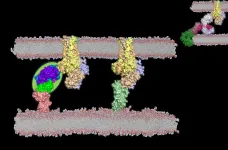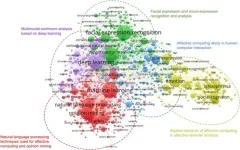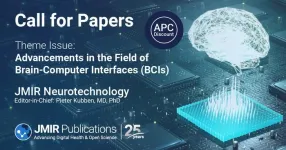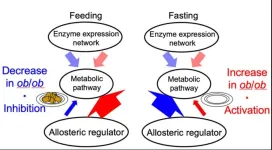(Press-News.org) Stanford researchers are getting closer to building a tiny electron accelerator based on “accelerator-on-a-chip” technology with broad potential applications in studying physics as well as medical and industrial uses.
The researchers have demonstrated that a silicon dielectric laser accelerator, or DLA, can now both speed up and confine electrons, creating a focused beam of high-energy electrons. “If the electrons were microscopic cars, it’s as if, for the first time, we’re steering and we have our foot on the gas,” said Payton Broaddus, PhD ’23 in electrical engineering and the lead author on a paper published on Feb. 23 detailing the breakthrough in Physical Review Letters.
Taking accelerators from miles to microns
Accelerators produce high-energy particle beams that allow physicists to study the properties of materials, produce focused probes for medical applications, and identify the elementary building blocks that make up all matter in the universe. Some of the earliest high-energy particle accelerators, developed in the 1930s, could fit on a tabletop. But higher particle energies were required to study more advanced physics, so scientists needed to build larger systems. (Powered up in 1966, the original linear accelerator tunnel at SLAC National Accelerator Laboratory on Stanford campus is almost 2 miles long.)
While these systems have made numerous discoveries in particle physics possible, Broaddus is motivated to build a tiny linear accelerator that could eventually rival the capabilities of machines more than a thousand times its size, at a fraction of the cost. This would also allow new applications in medicine, such as being able to attach this device to a small probe and precisely shoot an electron beam at a tumor. “There’s the ability to just completely replace every other particle accelerator with something that’s cheaper and smaller,” he said.
Thanks to advances in nano-scale fabrication and lasers, this vision is increasingly possible, said Olav Solgaard, director of the Edward L. Ginzton Laboratory and the Robert L. and Audrey S. Hancock Professor in the School of Engineering and the senior author on the paper. Traditional radiofrequency accelerators are made up of copper cavities that are pumped with radio waves, which give particles an energy boost. These pulses can heat up the metal, so the cavities need to operate at lower energy and pulse rates to dissipate the heat and avoid melting.
But glass and silicon structures can handle much higher energy pulses from lasers without heating up, so they can be much more powerful while also being smaller. About 10 years ago, Stanford researchers started experimenting with nano-size structures made of these materials. In 2013, a team led by paper co-author Robert Byer, the William R. Kenan, Jr. Professor, Emeritus, demonstrated that a tiny glass accelerator with pulsing infrared light had successfully accelerated electrons. These results led to the project being adopted by the Gordon and Betty Moore Foundation under the Accelerator on a Chip (ACHIP) international collaboration to produce a shoebox-sized mega-electron-volt accelerator.
But this first “accelerator on a chip” still had some kinks to work out. As Broaddus puts it, the electrons inside were like cars on a narrow road without steering wheels. They could accelerate very quickly but just as easily crash into a wall.
Steering electrons with lasers
Now, this team of Stanford researchers has successfully shown they can also steer electrons at the nanoscale. To do this, they built a silicon structure with a sub-micron channel placed in a vacuum system. They injected electrons into one end and illuminated the structure from both sides with a shaped laser pulse that delivered kicks of kinetic energy. Periodically, the laser fields flipped between focusing and defocusing properties, which bunched the electrons together, keeping them from swerving off track.
Altogether, this chain of acceleration, defocusing, and focusing acted on the electrons for a distance of almost a millimeter. It might not sound far, but these charged particles got quite the kick, gaining 23.7 kilo-electron-volts of energy, approximately 25% greater than their starting energy. The rate of acceleration the team has been able to achieve in their prototype tiny accelerator is comparable to conventional copper accelerators, and Broaddus adds that much higher acceleration rates are possible.
While it’s a significant step forward, there’s more that needs to be done before these small accelerators can be used in industry, medicine, and research. So far, the team’s ability to steer electrons has been limited to two dimensions; three-dimensional electron confinement will be required to allow the accelerator to be long enough for greater energy gains to occur.
Electron relay race
A sister research group at Friedrich Alexander University (FAU) at Erlangen, Germany, recently demonstrated a similar device with a single laser and starting at much lower starting energy. It and the Stanford device will ultimately be part of a kind of electron relay race, said Broaddus.
This future relay would have three teammates: The FAU device would take low-energy electrons and give them an initial kick, and then they could then be fed into a device similar to the one Broaddus is developing. The last step for the electrons would be an accelerator made of glass, like the one developed by Byer. Glass can withstand even greater pummeling by lasers than silicon, allowing the accelerator to further energize and push the electrons toward the speed of light.
Eventually, Solgaard believes such a tiny accelerator will be useful in high-energy physics, exploring the fundamental matter that makes up the universe just as its larger counterparts do. “We have a very, very long way to go,” he said. But he’s still optimistic, adding, “we’ve taken the first few steps.”
Additional Stanford co-authors include Dylan Black, PhD ’21; Yu Miao, PhD ’20; and PhD students Melanie Murillo and Clarisse Woodahl; and former research engineer Kenneth Leedle. Thilo Egenolf of Institut für Teilchenbeschleunigung und Elektromagnetische Felder in Darmstadt, Germany, is also a co-author.
Robert Byer is also a professor emeritus in applied physics in the School of Humanities and Sciences and in the SLAC National Accelerator Laboratory’s Photon Science Directorate and a member of Stanford Bio-X. Solgaard is also a professor of electrical engineering; a member of Bio-X, the Stanford Cancer Institute, and the Wu Tsai Neurosciences Institute; and an affiliate of the Precourt Institute for Energy and the Stanford Woods Institute for the Environment.
END
Steering and accelerating electrons at the microchip scale
2024-02-26
ELSE PRESS RELEASES FROM THIS DATE:
City of Hope scientists devise novel strategy to seek and destroy leukemia stem cells
2024-02-26
FINDINGS
Scientists at City of Hope, one of the largest cancer research and treatment organizations in the United States, have devised an innovative approach to target and destroy hard-to-kill leukemia stem cells. The journal Blood published the preclinical findings today.
By overcoming challenges, such as drug resistance and treatment relapse common to patients with acute myeloid leukemia (AML), the therapy method could provide a less toxic and more effective approach for older and sicker patients who don’t quality for stem cell transplants — currently the only cure for AML available.
Type II interferon (IFNy), a substance produced by immune cells, disrupts ...
Laser-focused look at spinning electrons shatters world record for precision
2024-02-26
NEWPORT NEWS, VA – Scientists are getting a more detailed look than ever before at the electrons they use in precision experiments.
Nuclear physicists with the U.S. Department of Energy’s Thomas Jefferson National Accelerator Facility have shattered a nearly 30-year-old record for the measurement of parallel spin within an electron beam – or electron beam polarimetry, for short. The achievement sets the stage for high-profile experiments at Jefferson Lab that could open the door to new physics discoveries.
In a peer-reviewed ...
BU researchers identify potential new subtype of chronic traumatic encephalopathy
2024-02-26
FOR IMMEDIATE RELEASE, February 26, 2024
Contact: Gina DiGravio, 617-358-7838, ginad@bu.edu
BU Researchers Identify Potential New Subtype of Chronic Traumatic Encephalopathy
One in six cases have a distinct distribution of disease, clinical profile
(Boston)—Chronic traumatic encephalopathy (CTE) is a neurodegenerative disease defined by abnormal tau protein accumulating in a particular pattern in specific regions of the brain.
Studies to-date suggest CTE begins in the outermost layer of the frontal lobe, the neocortex, where it then spreads to connected brain regions. Later, in high-stage disease, ...
BU researchers describe new technological platform to accelerate drug development
2024-02-26
EMBARGOED by Cell until 11 am ET Feb. 26, 2024
Contact: Gina DiGravio, 617-358-7838, ginad@bu.edu
BU Researchers Describe New Technological Platform to
Accelerate Drug Development
(Boston)— Drug development is currently an extremely long, expensive and inefficient process. Findings generated in a lab are often very hard to replicate once translated into animal models or in humans.
A family of pharmacological targets, on which approximately 35% of FDA-approved drugs work, consists of receptors at the surface ...
The small intestine adapt its size according to nutrient intake
2024-02-26
One of the most striking examples of gut plasticity can be observed in animals that are exposed to prolonged periods of fasting, such as hibernating animals or phyton snakes that goes for months without eating, where the gut shrinks with as much as 50%, but recovers in size following a few days of re-feeding. Importantly, the capacity of the gut to undergo resizing is broadly conserved. Hence, in humans, an increase in gut size is observed during pregnancy, which facilitates the uptake of nutrients to support the growth of the fetus.
The Colombani Andersen ...
Is it possible to predict when prejudice will occur?
2024-02-26
What if it were possible to use a scientific model to predict hate crimes, protests, or conflict? Researchers at McGill University and University of Toronto have begun the groundwork to develop a formal predictive model of prejudice, similar to meteorological weather predictions.
The model can be explained by the equation: Prejudice = Threat – Contact + Identification, “with some numbers involved,” says lead author Eric Hehman, Associate Professor in the Department of Psychology and lead author of a new study published in Psychological ...
Affective computing: Connecting computing with human emotions for empathetic AI
2024-02-26
Imagine a world where your smartphone can detect your mood just by the way you type a message or the tone of your voice. Picture a car that adjusts its music playlist based on your stress levels during rush hour traffic. These scenarios are not just futuristic fantasies. They are glimpses into the rapidly evolving field of affective computing. Affective computing is a multidisciplinary field integrating computer science, engineering, psychology, neuroscience and other related disciplines. A new and comprehensive review on affective computing was published Jan. 5 in Intelligent ...
Demystifying “black box” audio models
2024-02-26
AI decision-making is now common in self-driving cars, patient diagnosis and legal consultation, and it needs to be safe and trustworthy. Researchers have been trying to demystify complex AI models by developing interpretable and transparent models, collectively known as explainable AI methods or XAI methods. A research team offered their insight specifically into audio XAI models in a review article published Jan. 23 in Intelligent Computing, a Science Partner Journal.
Although audio tasks are less researched than visual tasks, their expressive power is not less important. Audio signals are easy to understand and communicate, as they typically depend less on expert explanations ...
JMIR Neurotechnology invites submissions on brain-computer interfaces (BCIs)
2024-02-26
JMIR Publications is pleased to announce a new theme issue in JMIR Neurotechnology exploring brain-computer interfaces (BCIs) that represent the transformative convergence of neuroscience, engineering, and technology. The peer-reviewed journal aims to bridge the gap between clinical neuroscience and information technology by providing a platform for applied human research in the field of neurology.
JMIR Neurotechnology welcomes submissions from scientists, clinicians, and technologists. PhD students and early career researchers are ...
Obesity disrupts normal liver function in mice
2024-02-26
Your liver plays a vital role in your metabolism, the biological process which converts food into energy. We know that being overweight can negatively affect metabolic activity, but not exactly how. To better understand this, researchers compared the livers of mice which were a typical weight with mice which were obese. They were surprised to find that biological regulation of metabolic activity, after a period of feasting and fasting, was reversed between them. In typical mice, allosteric regulation (the process which controls metabolism) was inhibited during feeding and activated when fasting. However, ...




